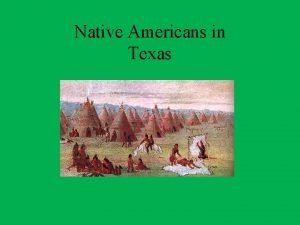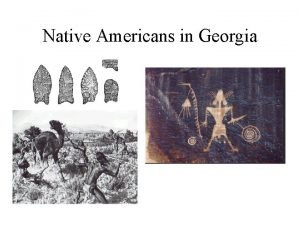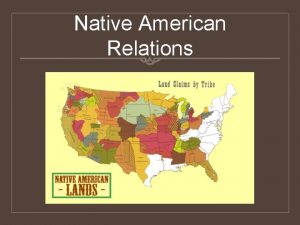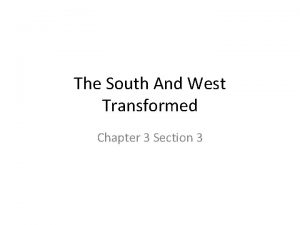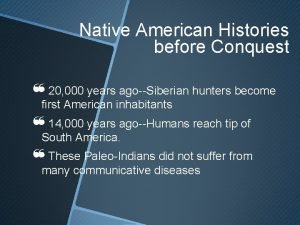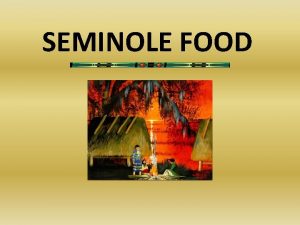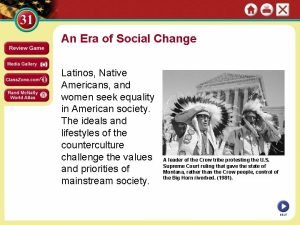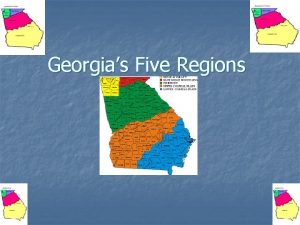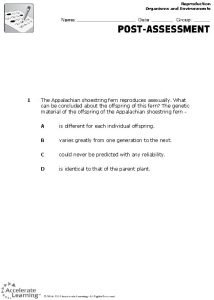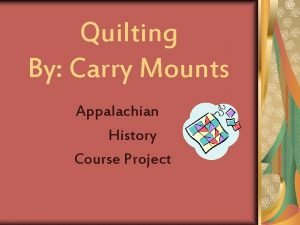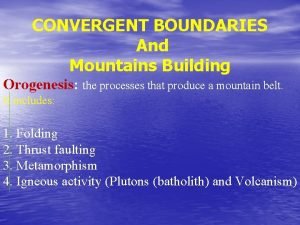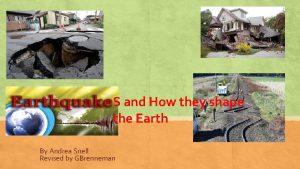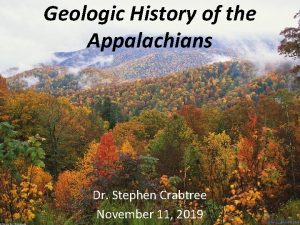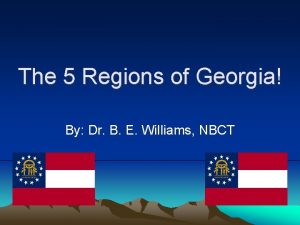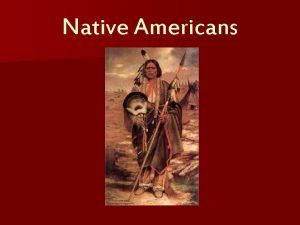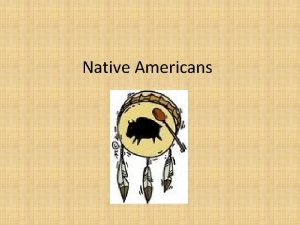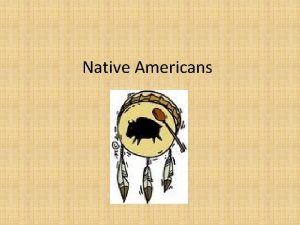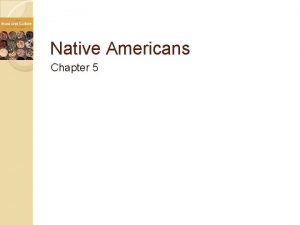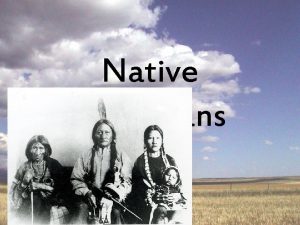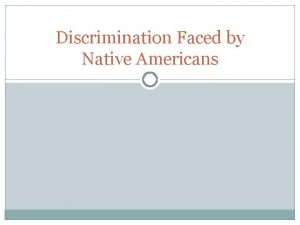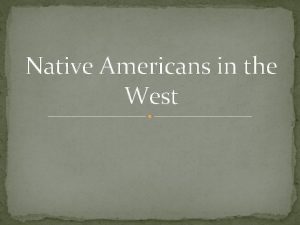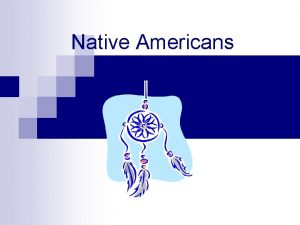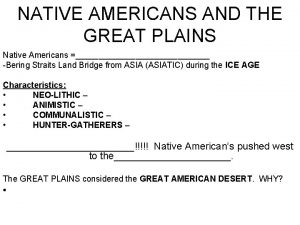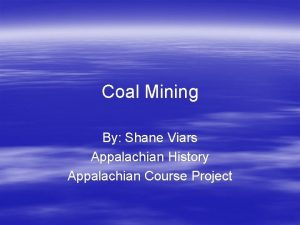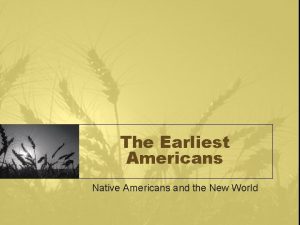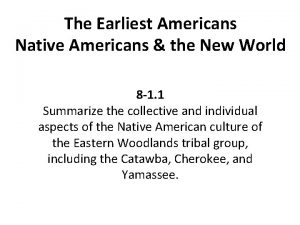APPALACHIAN HISTORY INTRODUCING APPALACHIAN STUDIES NATIVE AMERICANS Native
























- Slides: 24

APPALACHIAN HISTORY INTRODUCING APPALACHIAN STUDIES

NATIVE AMERICANS ● Native Americans had been living in Appalachia for 3, 000 years prior to European contact. ● Iroquois: 1300 B. C. from West; split into Northern Iroquois and Southern Cherokee. ● Yuchi Indians in Southwest Virginia, assimilated into Cherokee society prior to much of the recorded history of native peoples. ● The “Peoples of Appalachia” section will address Cherokee culture

CHEROKEE ● 1700 -1761: contact and conflict escalates as Europeans seek settlement expansion and skins for trading ● 1761: final defeat of Cherokee by British; white expansion increases rapidly ● People & Nature ○ Cherokee: language, names, religious beliefs based upon relationship between people and environment; humans part of natural world, not superior ○ Europeans: urged by God to conquer nature and be its master ● Indian Removal Act of 1831 ○ 1/4 of Cherokees die on 1838 trek westward; Trail of Tears ○ Some escaped to mountains of North Carolina, settled in Qualla Boundary

EUROPEAN SETTLEMENT ●First half of 18 th century in Great Valley of VA ●Immigrant populations grow, conquest of Indian lands, land speculation in Appalachia all contribute ●Blue Ridge Mountains and Great Valley become American frontier prior to Revolutionary War ●Flow into Appalachia in 18 th century: central valley of Pennsylvania, Piedmont of North Carolina, western Pennsylvania ●Earliest immigrants (1720) from eastern Pennsylvania were German and Scots-Irish into Shenandoah Valley, eventually expanding to Carolina Piedmont, then to southwestern VA, western NC, and eastern TN ●By 1760, western PA sends German, Scots-Irish

ULSTER PLANTATION ● King James VI of Scotland (King James I of England) ○ United thrones of England, Scotland, and Ireland in 1603 ○ Promoted "plantation of Ireland" by lowland Scots and some English to subdue Catholic Irish ○ Many Scots were Presbyterian: persecuted by Episcopal Church of Ireland, Catholics, and Anglican Church ○ Eventually left for religious, economic (linen industry depression), and rack-renting (renting to the highest bidder) reasons ○ By the way, this is the King James of the King James version of the Christian Bible and ruled During the latter portion of the writings of William Shakespeare

APPALACHIA & THENEW NATION ● Small number of British (many Welsh) migrate from east coast of VA in mid-1700 s; some with slaves ● African American population at 10% prior to Civil War; higher in some areas ● Tension between small mountain farmers and flatland plantation owners begins early and would remain ● Feeling of Appalachian alienation leading up to Revolutionary War led to hostility toward political elites ● Appalachians eventually supported war due to desire for religious freedom (Germans) or hatred of British royalty (Scots-Irish)

KINGS MOUNTAIN ● Turning point in Revolutionary War – October 7, 1780 ● Patriot vs. Loyalist Militia – a “civil” war of mostly Americans ● Patriots: William Campbell (VA)--commander, Isaac Shelby (TN), John Sevier (TN), Benjamin Cleveland (NC), James Williams (SC), Edward Lacey (SC), Frederick Hambright (NC), Joseph Mc. Dowell (NC), Joseph Winston (NC) ● Loyalist: Major Patrick Ferguson— only British army officer in battle ● Challenge to Patriot leaders from Ferguson: Lay down arms or I’ll “lay waste to their country with fire and sword” ● The bayonet charge from Ferguson proved Unsuccessful and Ferguson shot from his horse ● 65 -minute battle ending in Patriot victory

Kings Mountain

PREINDUSTRIAL APPALACHIA ● Small, open-country communities and scattered settlements prior to industrialization ● Self-sufficiency, socially and economically ● Shared identity, common ideals and values, shared work and church provides unity ● Contradicting Appalachian isolation as reason for strong community ○ First 2/3 of 19 th century, Appalachia was no more isolated than other rural areas ● Economy ○ Non-commercial, self-sufficient farms; some evidence that farming for external market took place ○ Salt works, iron foundries, copper mines, tanneries existed - some industry

PREINDUSTRIAL APPALACHIA (CONT. ) ●Appalachian farmers relied on family labor: build homesteads, cultivate orchards and livestock pastures, garden, graze hogs, raise turkeys and geese ●Most common crop: corn (milled and "liquified") ●Family was center of pre-industrial life; framework for education and social order ●Gender and age roles clearly defined ●Patriarchal society, but women maintained strong, influential positions within family ●Social activities: ○Church ○Community work: house/barn construction; clearing new ground; harvesting crops; preserving food; hog butchering; husking corn; road building/maintenance; etc.

CIVIL WAR &RECONSTRUCTION ● Slavery as a component of controversy in Appalachia during Civil War ● Fewer than 1 in 10 whites owned slaves in region (1 in 4 in South), but yes, it did exist in the mountains ● Slavery largely in bigger valleys in VA and TN ● Industrial slavery existed in tanning works, salt mines, iron foundries of VA and brick mills of TN and KY ● Quakers & Germans in Appalachia opposed slavery on moral, ethical, and religious grounds; majority of people opposed for political, economic reasons ● Stay with Union or side with Confederacy? ○ Pitted community against community, county against county, etc.

CIVIL WAR &RECONSTRUCTION ● Strongest areas of Unionist sentiment: western counties of VA, East TN, western North Carolina, eastern KY ● The Great Divide: 1/3 of Appalachia's residents sided with Union, 1/3 with Confederacy, 1/3 neutral ● 1861: 27 counties declared secession of their state illegal; became West Virginia in 1863 ● Confederate sentiment: strongest in valleys of Appalachia and in mountain counties close to flatlands in Blue Ridge of VA and western NC; economic/political elite ● "Living off the land": Both Union & Confederate soldiers destroyed crops and livestock, robbed and burned homes, killed civilians, causing widespread hunger

CONSCRIPTION ● April 1862 – Confederate conscription (or draft) ● Exempted “one potential soldier for every twenty slaves owned by a family” ● Angered small-scale farmers, who called it a rich man's war, and a poor man's fight ● Upset balance between community needs and needs of confederacy ● 1863 – Federal draft ensured that Union areas of Appalachia suffered the same fate ● As a result, transportation system fell into Disrepair as well as other infrastructure elements

CIVIL WAR &RECONSTRUCTION ● Lincoln promised support after war's end, but assassinated ● Political situation during Reconstruction left mountain counties (traitors to the Confederacy) neglected: transportation, public school, public services ● By 1880 s, Appalachia was discovered by northern and foreign investors, interested in natural resources ● Writers, missionary workers, teachers accompanied capitalists ●The result was a new picture of Appalachia that stressed poverty and cultural backwardness

EARLY INDUSTRIALIZATION ● Stereotype of unchanged frontier culture: noble savages ● Independent, proud, rugged, violent, dirty, uneducated, crafty, practical, drank too much, lazy, large families, etc. , as described by outsiders ● Local Color Movement begins ● Appalachia was a region in stark contrast to progressive, urban culture of rest of US ● Responses to emerging image of Appalachia ○ Middle-class women from northeast sought to educate mountain people ○ Cultural preservation (ballad collecting, etc. ) ○ Economic development and industrialization ○ Culture becomes commodity

EARLY INDUSTRIALIZATION ●From 1865 to 1920: US becomes world's largest industrial nation ●Demand for labor, minerals, timber ●The "coming of the roads" (railroads) between 1870 and 1910 ●Coal became most valuable natural resource; innovations in iron and steel making created demand ●Mine owners and operators: ○College educated ○Middle or upper-middle class ○Close ties to railroads ○Largely outsiders ○Established company town system; wielded great political and economic power ●Workers: native Appalachians, African Americans, immigrants from southern/eastern Europe

IMPACT OF INDUSTRIALIZATION ●African Americans moved to mine coal in great numbers to West Virginia and eastern TN ●Coal camps were segregated; mine work was not ●Italians, Poles, and Slavs also provided labor ●By 1900, immigrants had largely replaced native workforce ●Work conditions: ○Low wages (average of $2. 00 a day in 1900) ○Unsafe work conditions: explosions, poor ventilation, coal dust in the air, rock and roof falls ●Company towns became necessary to promote industrialization due to level of immigration ●From 1880 to 1930, over 600 company towns; 5 -to-1 over independent towns in Appalachia

IMPACT OF INDUSTRIALIZATION ● Life in company towns varied: ○ quality of housing ○ degree of overcrowding ○ quality of sanitation and recreation ○ policies of company store ○ degree to which company sought to control people's activities ● Other industries during period ○ timber ○ textiles ○ railroading ○ non-coal mineral mining ○ chemical production ● Industry largely affected the region's economic situation negatively due to absentee corporations

THE GREAT DEPRESSION &NEW DEAL ● Farming prior to the Great Depression ○ Appalachia – 3% of U. S. Land area ○ According to 1930 Census – 1/3 of “self-sufficing” farms ○ Self-sufficing farm is where the value of the [home] farm products used by the family was 50 percent or more of the total value of all products of the farm ○ Income < $100 per year on self-sufficing farms ○ Some barely affected by Depression, but wage laborers would feel the impacts deeply

THE GREAT DEPRESSION &NEW DEAL ●Depression of the 1930 s began earlier in Appalachia when industry collapsed from overproduction and competition ●Couldn't return to agriculture; couldn't pursue other opportunities ●Mid-1920 s to early 1940 s--Appalachia's Great Depression ●End of 1930 s: 75% of mountain population receiving government assistance ●Many moved north; many stayed in inactive coal camps ● 1933's New Deal--didn't end hard times, but helped ● 1935: Wagner Act allows unions to be formed and that right to be federally protected ●Tennessee Valley Authority begins to regulate river flooding, restore eroded land, produce fertilizers, etc.

THE GREAT DEPRESSION AND NEW DEAL ● 1949: TVA builds 9 coal-powered electrical generating plants ● Push toward recent development of strip-mining

APPALACHIA AT MIDCENTURY &BEYOND ●World War II and effects on mountain people ●People uprooted and exposed to world away from home in record numbers ○Greater sense of difference and, sometimes, a feeling of inferiority ■Some would leave Appalachia afterward for better jobs; great out-migration to North and Midwest in 1950 s and 1960 s ○For some, it expanded horizons, aspirations, and attitudes ●Technological improvements during WWII eventually led to decline in workers; 476, 000 coal miners in 1940 and less than 200, 000 in 1960 ●Between 1945 and 1965, nearly 3. 5 million people left for Cincinnati, Detroit, Columbus, Chicago, Cleveland, Indianapolis, Baltimore; They were often called “briers”

APPALACHIA AT MIDCENTURY &BEYOND ● 1950 s: Appalachia rediscovered in media reports highlighting poverty ●Democratic Presidential nomination of 1960: JFK, Lyndon Johnson, and Hubert Humphrey visit mountains ●Media attention was huge following the election; Appalachia generally presented negatively ●Appalachians resented images of isolation, backwardness, ignorance, and pathetic impoverishment ●The outside feeling that Appalachia was in America, but not of America ● 1963: Johnson pledges to fulfill Kennedy's programs and Appalachian Regional Development Act is passed ●Appalachian Regional Commission created by the bill and War on Poverty begins ●Four areas of ARC: highway construction, resource development, flood control and water tower projects, improvements in human services

APPALACHIA AT MIDCENTURY &BEYOND ● ARC includes 393 counties in 13 states from New York to Mississippi originally ● Other Programs: OEO, VISTA, Head Start ● Although these programs were largely unsuccessful, Appalachians began to see their own potential to create change; swelling of regional pride and identification with "Appalachia" ● Appalachia remains a contradiction in America: a region rich in natural resources yet a land of great poverty.
 Coahuiltecan tattoos
Coahuiltecan tattoos Where did native americans come from
Where did native americans come from How many native americans died on the trail of tears
How many native americans died on the trail of tears What three circumstances hurt native american
What three circumstances hurt native american Portuguese sailor
Portuguese sailor What did seminoles eat
What did seminoles eat Latinos and native americans seek equality
Latinos and native americans seek equality Paradigm shift from women studies to gender studies
Paradigm shift from women studies to gender studies Regions of nj
Regions of nj Seven landform regions of canada
Seven landform regions of canada What formed the appalachian mountains
What formed the appalachian mountains Coastal plains region landforms
Coastal plains region landforms Where is the appalachian plateau located in georgia
Where is the appalachian plateau located in georgia The appalachian shoestring fern reproduces asexually
The appalachian shoestring fern reproduces asexually Appalachian quilt patterns
Appalachian quilt patterns Appalachian mountain range
Appalachian mountain range Appalachian storage hub
Appalachian storage hub Appalachian plateau products and industries
Appalachian plateau products and industries Places to visit in appalachian plateau
Places to visit in appalachian plateau Appalachian mountains convergent boundary
Appalachian mountains convergent boundary Where is the appalachian mountains
Where is the appalachian mountains Appalachian range
Appalachian range 6 major physical features in georgia
6 major physical features in georgia Appalachian
Appalachian 5 regions of georgia
5 regions of georgia
